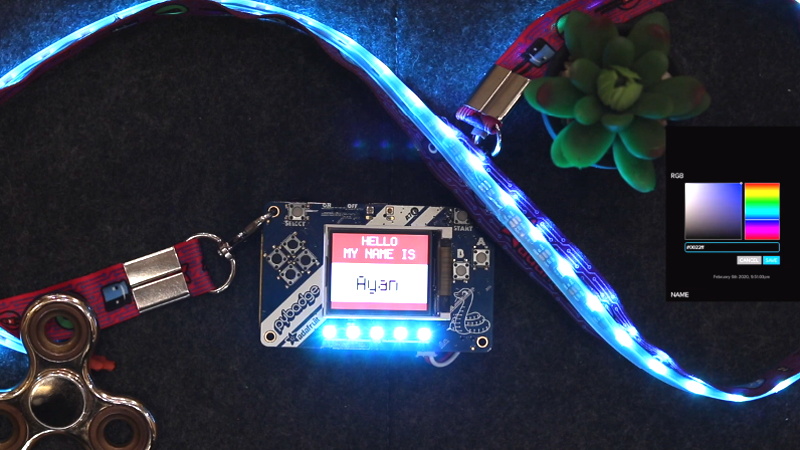Today, nearly every modern consumer device wants to connect to the Internet for some reason. From your garage door opener to each individual smart bulb, the Internet of Things has arrived in full force. But the same can’t be said for most of our beloved conference badges. Wanting to explore the concept a bit, [Ayan Pahwa] set out to create his own MQTT-connected badge that he’s calling CloudBadge.
 As this was more of a software experiment, all of the hardware is off-the-shelf. The badge itself is an Adafruit PyBadge, which doesn’t normally have any networking capabilities, but does feature a Feather-compatible header on the back. To that [Ayan] added a AirLift FeatherWing which allows him to use the ESP32 as a co-processor. He also added a strip of NeoPixel LEDs to the lanyard, though those could certainly be left off if you’re not looking to call quite so much attention to yourself.
As this was more of a software experiment, all of the hardware is off-the-shelf. The badge itself is an Adafruit PyBadge, which doesn’t normally have any networking capabilities, but does feature a Feather-compatible header on the back. To that [Ayan] added a AirLift FeatherWing which allows him to use the ESP32 as a co-processor. He also added a strip of NeoPixel LEDs to the lanyard, though those could certainly be left off if you’re not looking to call quite so much attention to yourself.
The rest was just a matter of software. [Ayan] came up with some code that uses the combined hardware of the PyPadge and ESP32 to connect to Adafruit.io via MQTT. Once connected, the user is able to change the name that displays on the screen and the colors of the RGB LEDs through the cloud service. If you used something like this for an actual conference badge, the concept could easily be expanded to do things like flashing the badge’s LEDs when a talk the wearer wanted to see is about to start.
The modern conference badge has come a long way from simple blinking LEDs, offering challenges that you’ll likely still be working on long after the event wraps up. Concerns over security and the challenge of maintaining the necessary infrastructure during the event usually means they don’t include networking features, but projects like CloudBadge show the idea certainly has merit.
















“nearly every modern consumer device wants to connect to the Internet for some reason”
Depends, there are techniques to find your peers in the LAN:
https://github.com/zoobab/zyre-fosdem2020
MQTT has the problem of being a slave that needs to talk to a master, while Zyre will find other peers in the LAN, and start talking to them on a predefined channel, or even with Curve crypto messages and preconfigured keys.
The problem is the protocol.
if you don’t need to route your messages then you can ditch TCP/IP completely and send your own packet frames around, kind of like the old MS-DOS games that used Netware packets. You will have to invent your own auto-discover protocols and the like, but that’s part of the fun.
“The rest was just a matter of software.”
And that, kids, is how I vastly underestimated the scope of the project.
Mqtt on a badge…
What’s the battery life like vs response time?
A nearly linear tradeoff!
(Except for the fixed cost of getting on the WiFi network.)
Haha, thanks